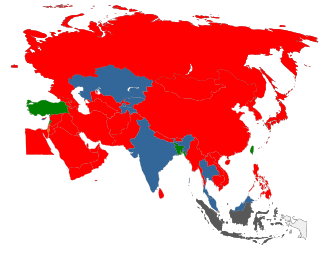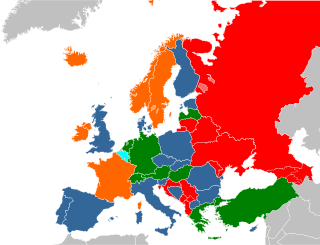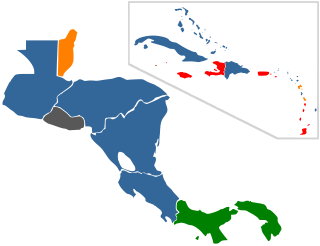Related Research Articles

The legality of prostitution in Asia varies by country. There is often a significant difference in Asia between prostitution laws and the practice of prostitution. In 2011, the Asian Commission on AIDS estimated there were 10 million sex workers in Asia and 75 million male customers.
Prostitution in Peru is legal and regulated. UNAIDS estimate there to be 67,000 prostitutes in the country.
Prostitution in Ecuador is legal and regulated, as long as the prostitute is over the age of 18, registered, and works from a licensed brothel. Prostitution is widespread throughout the country. Many brothels and prostitutes operate outside the regulatory system and the regulations have been less strictly enforced in recent years. 25,000 prostitutes were registered in the year 2000. In 2007 it was estimated that 70% of the prostitutes in the country were from Colombia. The country attracts Colombian prostitutes as the currency is the US$ rather than the unstable Colombian peso. UNAIDS estimate there to be 35,000 prostitutes in the country.
Prostitution in Costa Rica is legal. Costa Rica's legal system is based on Roman law rather than common law, and so for prostitution to be illegal it would have to be explicitly stated as such in a penal code, and it is not. Nevertheless, many of the activities surrounding it are illegal, as the law forbids promoting or facilitating the prostitution of another, and therefore pimping, brothels, or prostitution rings are illegal. Prostitution is common and is practiced openly throughout the country, particularly in popular tourism destinations.
Prostitution in Paraguay is legal for persons over the age of 18, but related activities such as brothel keeping are prohibited. Prostitution is common in the country. Brothels are also common, even some rural villages have a small bar/brothel on the outskirts.
Prostitution in Latvia is legal and regulated. The country is a destination for sex tourism.

Prostitution in Ukraine is illegal but widespread and largely ignored by the government. In recent times, Ukraine has become a popular prostitution and sex trafficking destination. Ukraine is a source, transit, and destination country for women and children trafficked transnationally for the purposes of commercial sexual exploitation. Ukraine's dissolution from the Soviet Union, saw the nation attempt to transition from a planned economy to a market economy. The transition process inflicted economic hardship in the nation, with nearly 80% of the population forced into poverty in the decade that followed its independence. Unemployment in Ukraine was growing at an increasing rate, with female unemployment rising to 64% by 1997. The economic decline in Ukraine made the nation vulnerable and forced many to depend on prostitution and trafficking as a source of income. Sex tourism rose as the country attracted greater numbers of foreign tourists.
Prostitution in Kazakhstan is itself legal, but acts facilitating prostitution, such as operating a brothel or prostitution ring, are illegal. Forced prostitution and prostitution connected to organised crime are prohibited. Prostitution is a serious problem. NGOs reported that criminal prostitution rings often included local law enforcement officials.
Prostitution in Panama is legal and regulated. Prostitutes are required to register and carry identification cards. However, the majority of prostitutes are not registered. There are 2,650 sex workers registered with the government in 2008, but there was no accurate information regarding the total number of persons practising prostitution in the country. Some estimate put the number of unregistered prostitutes at 4,000.

Prostitution is legal and regulated in Bangladesh. Prostitutes must register and state an affidavit stating that they are entering prostitution of their own free choice and that they are unable to find any other work. Bangladeshi prostitutes often suffer poor social conditions and are frequently socially degraded.
Prostitution in El Salvador is not prohibited by national law, but may be prohibited by local municipal ordinances. Municipal ordinances may also prohibit the purchase of sexual services. Related activities such as facilitating, promoting or giving incentives to a person to work as a prostitute (pimping) are illegal. The prostitution of children is also illegal. Brothel ownership, however, is legal. There are no specific laws against human trafficking, but any criminal offence that includes ‘commerce in women or children’ requires sentencing to be increased by 30%.
Prostitution in Uganda is illegal according to Uganda's 1950 Penal Code, but is widespread despite this. Many turn to prostitution because of poverty and lack of other opportunities. A study of Kampala teachers in 2008 showed that teachers were turning to prostitution to increase their income. A sex worker can earn around USh.1.5 million/= (£439 sterling) per month, whereas this would be a yearly wage for a secondary school teacher. There are many Kenyan prostitutes in the country.

The legality of prostitution in Europe varies by country.
Prostitution in Suriname is illegal but widespread and the laws are rarely enforced. Human trafficking and Child prostitution are problems in the country. Prostitutes are known locally as "motyo". UNAIDS estimate there to be 2,228 prostitutes in the country.
Prostitution in Burkina Faso is not specifically prohibited by the law, but soliciting and pimping are illegal. Burkinabe society only accepts sexual intercourse within marriage. In 2009, Voice of America reported that the number of prostitutes in Burkina Faso had increased as a result of the country's poverty. The increase in prostitution has given rise to fears of an increase in the number of Burkinabés infected with HIV and AIDS. UNAIDS estimate there to be 31,000 prostitutes in the country.

Prostitution laws varies widely from country to country, and between jurisdictions within a country. At one extreme, prostitution or sex work is legal in some places and regarded as a profession, while at the other extreme, it is considered a severe crime punishable by death in some other places.
Prostitution in Namibia is legal and a highly prevalent common practice. Related activities such as solicitation, procuring and being involved in the running of a brothel are illegal. A World Bank study estimated there were about 11,000 prostitutes in Namibia.
Prostitution in the Democratic Republic of the Congo is legal but related activities are prohibited. The Congolese penal code punishes pimping, running a bawdy house or brothel, the exploitation of debauchery or prostitution, as well as forced prostitution. Activities that incite minors or promote the prostitution of others have been criminalised. The government does little to enforce the law. During the colonial era and the years that followed independence, the Ministry of Health issued calling cards identifying professional sex workers and provided them with medical health checks. However, this system was abandoned in the 1980s. Public order laws are sometimes used against sex workers. Street prostitutes report harassment, violence and extortion from the police. UNAIDS estimated there are 2.9 million sex workers in the country.
Prostitution in the Central African Republic is legal and commonplace. Procuring or profiting off the prostitution of others is illegal, as is coercing people into prostitution. Punishment is a fine and up to one year in prison, or 5 years if the case involves a minor.

Legality of prostitution in the Americas varies by country. Most countries only legalized prostitution, with the act of exchanging money for sexual services legal. The level of enforcement varies by country. One country, the United States, is unique as legality of prostitution is not the responsibility of the federal government, but rather state, territorial, and federal district's responsibility.
References
- 1 2 3 4 5 6 "Sexuality, Poverty and Law Programme". Institute of Development Studies. Retrieved 17 December 2017.
- 1 2 3 4 Gorondi, Pablo (24 September 2007). "Hungary Gives Permits to Prostitutes". Washington Post. Retrieved 17 December 2017.
- ↑ "The Legal Status of Prostitution by Country". ChatsBin. Retrieved 17 December 2017.
- 1 2 3 4 "SZEXE (Association of Hungarian Prostitutes), Hungary". SWAN. 14 April 2006. Retrieved 17 December 2017.
- 1 2 3 "A Szexmunkások Érdekvédelmi Egyesületéről Roviden". SZEXE (in Hungarian). Retrieved 17 December 2017.
- 1 2 3 "Trafficking in Persons Report 2009 - Hungary". UNHCR . Archived from the original on 8 October 2012. Retrieved 2 October 2008.
- 1 2 "2008 Human Rights Report: Hungary". US State Department . Archived from the original on 26 February 2009. Retrieved 2 October 2008.
- ↑ "Hungary 2018 Trafficking in Persons Report". U.S. Department of State. Archived from the original on 28 July 2018. Retrieved 26 July 2018.
